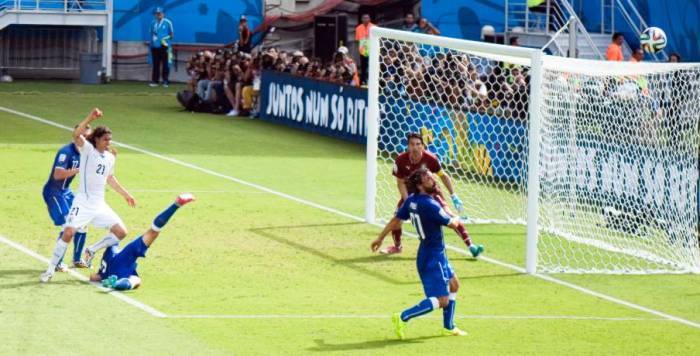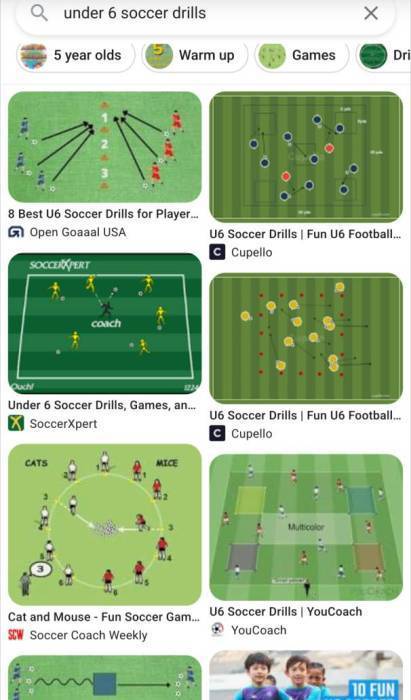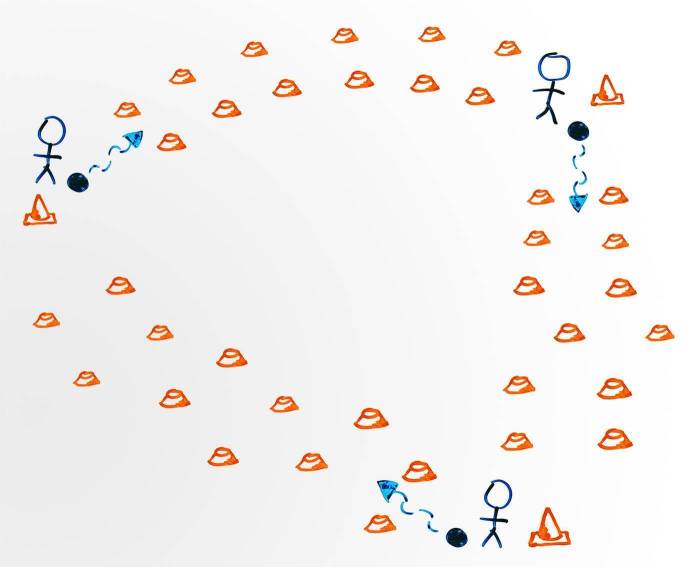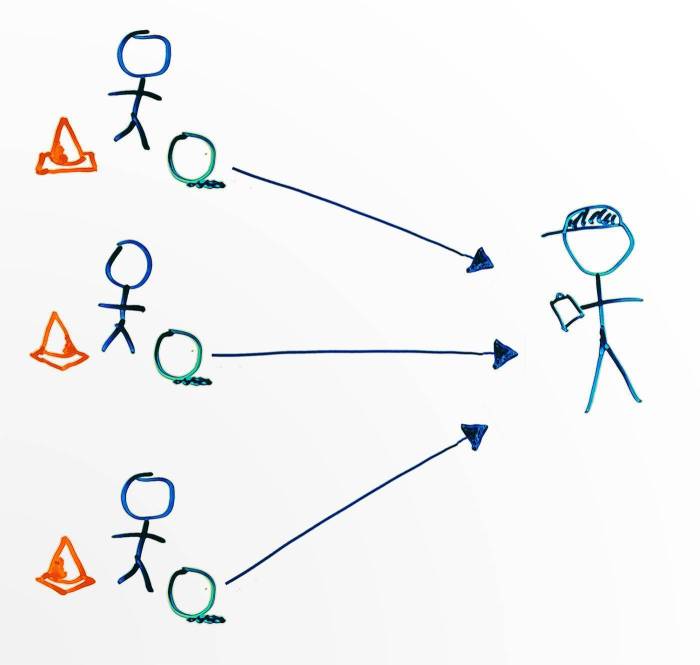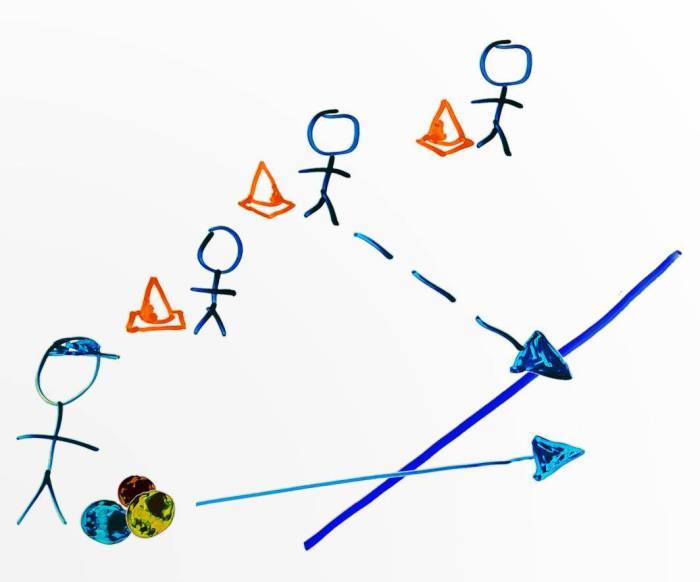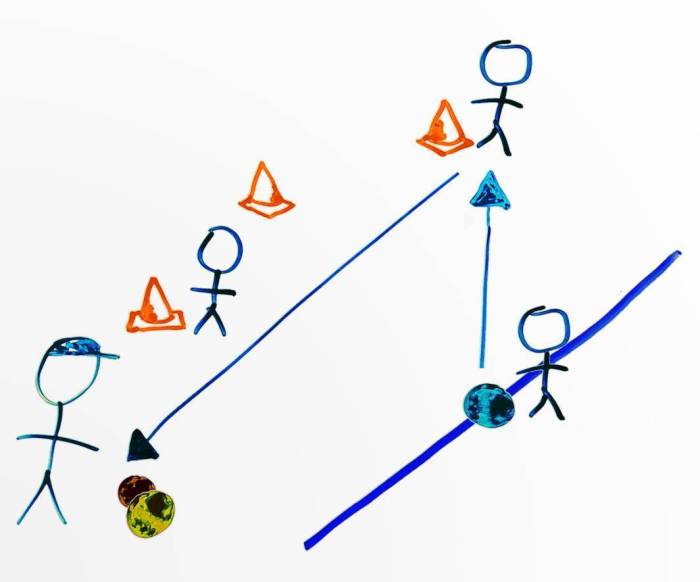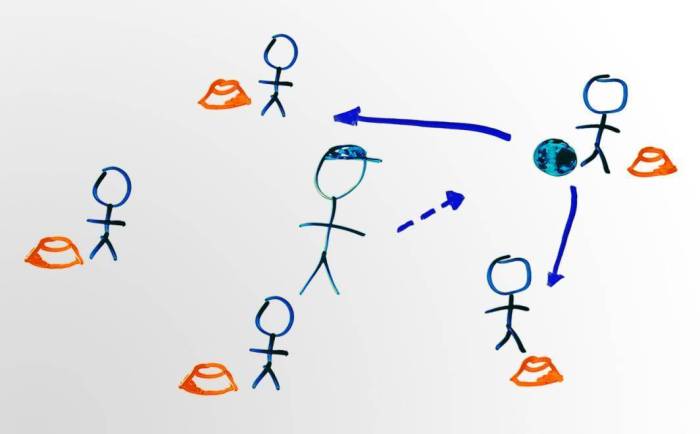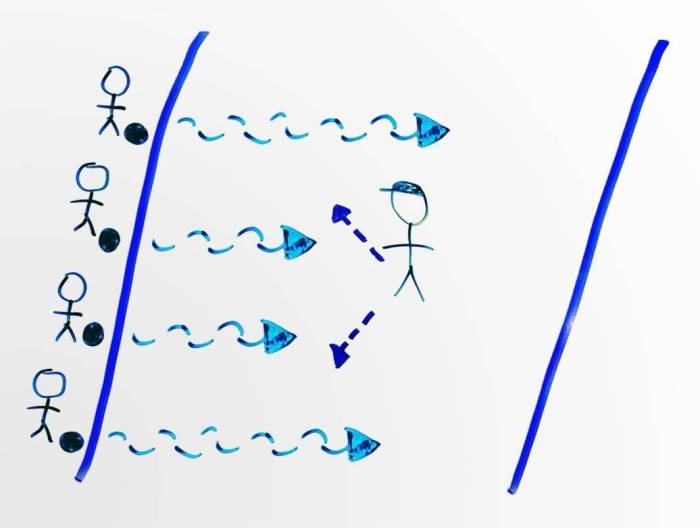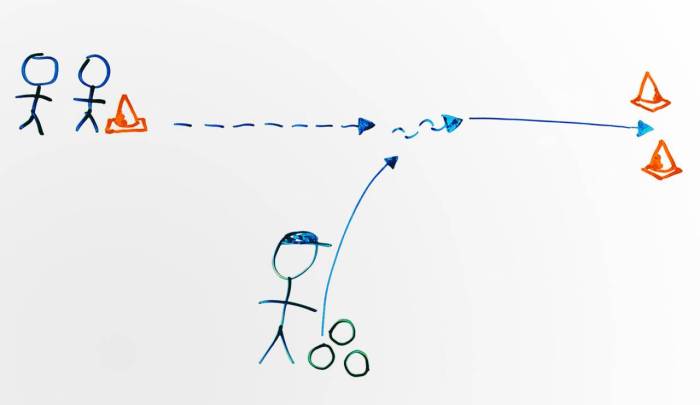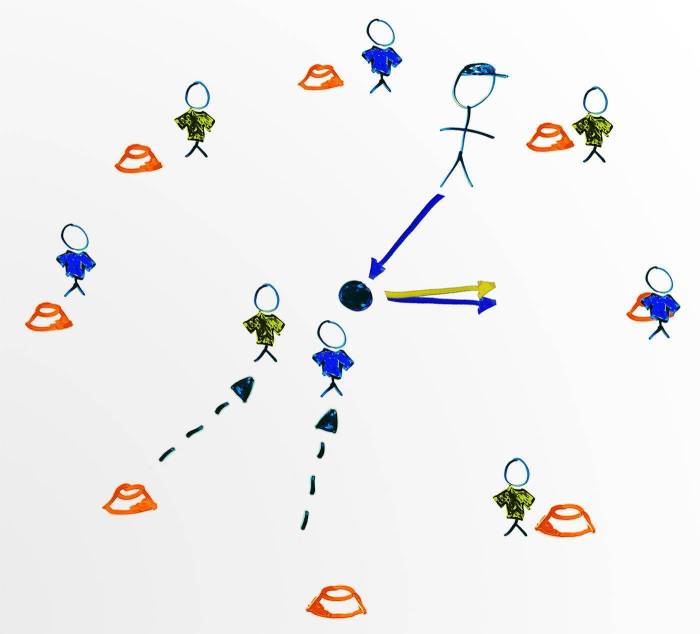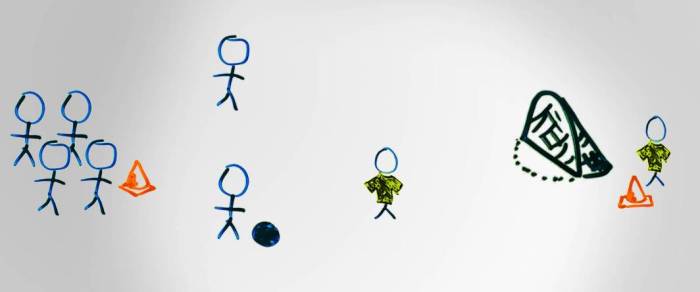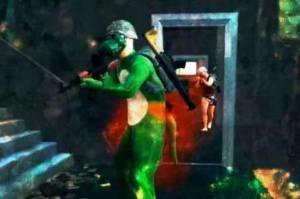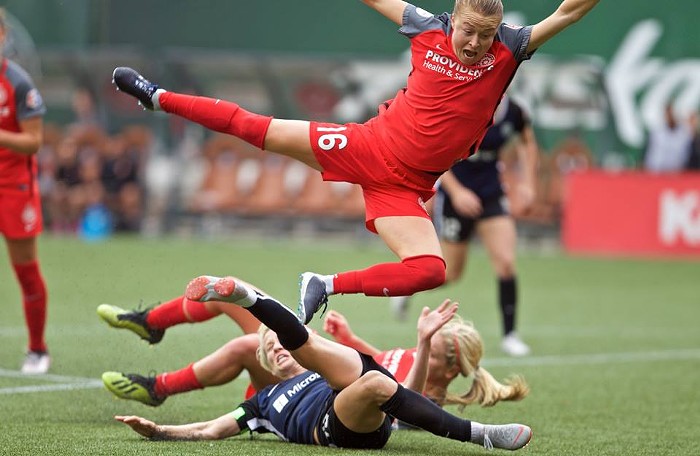I recently became assistant coach of
Dani's U-6 soccer team. I wasn't sure what to expect - it's been quite some time since I played U-6. From friends with kids, I vaguely knew to expect "bunchball and kids chasing butterflies in the middle of the game". Nothing wrong with that, there's no reason to be doing burpees and slide tackling at this age.
So what was the right way to teach soccer-ish things while still having a good time?
Three practices and one game have been very enlightening. So
before going to the clipboard, I have a few observations about soccer at this age.
What U-6 is like
Age
Five years old is way different from three years old. My kid mostly wants to take her shoes and shinguards off and wander around the park (it's a good thing that
Jes is there). There are a couple of older kids on the team that have the fundamental skills down and are there to play (but mostly want to scrimmage). Kids in the middle of the age range have adequate focus but are sometimes intimidated by drills and older players.
Tactics
The amoeba is real:
games and scrimmages consist largely of both teams clustering around the ball, trying to steal it and dribble away. The ball does go out of bounds more frequently than I expected, so it's good that we've practiced kick-ins.
Goals are mainly scored when an older kid manages to knock the ball clear of the amoeba, or sometimes simply dribble out. For this reason, I think
chasing down 50/50 balls is the most important aspect of U-6. That's not to say we should give up on teaching passing, but I think it's fine to focus on the skills that the kids will see in a game.
On the offensive side, this means practicing playing the ball on the run. Defensively,
we could theoretically prevent a few goals by having a player hang back from the amoeba to sweep loose balls. I'm not sure "hang back from the cluster" is teachable at this age, but for what it's worth one of the older kids did this for awhile during our first game (and was pretty successful).
The other opportunity to improve our defense:
we had goals scored on us when the last defender tried to steal the ball rather than clear it. Basically, executing a steal and dribble is considerably more difficult than simply knocking the ball away. Since the kids don't mind blasting the ball during passing drills, I imagine we can teach this defensive skill. Conversely, the tendency of defenders to play this way means that the push and run could be a useful technique.
Drills
Attention spans are probably the biggest factor in practice.
If a kid is standing in line for more than ten seconds she'll probably become distracted. Even in a scrimmage, if the older players are running the show, the younger players quickly become disinterested.
It's annoying to google "U-6 drills" and see elaborately choreographed schemes with ten players and one ball. That said, there's decent material out there, you just have to look at everything with skepticism.
And so
I decided to start my own book of drills based on distant memories and internet resources. I'll add any future ideas to this post.
Dribbling course
|
|
|
The players execute three dribbling course segments. |
|
Requirements
|
- 3-6 players
- 1 ball per player
|
|
Description
|
The players dribble through a cone course, either segment-by-segment or as a full loop.
|
|
Variants
|
- Different cone patterns.
- Dribbling restricted to one foot.
|
|
Outcomes
|
Naturally, this drill teaches dribbling.
|
|
Status
|
Kids this age are surprisingly good at dribbling, the only concern here is attention.
|
Footgolf
|
|
|
The players try to place their pass as close to the coach as possible. |
|
Requirements
|
- 2-5 players
- 1 coach
- 1 ball per player
|
|
Description
|
- The players stand near a cone, arranged in a line or arc.
- The coach (target) chooses a spot at some distance from the players.
- On the coach's signal, the players kick their ball, trying to get it to come to rest nearest the coach.
- The coach returns the balls and picks a new spot.
|
|
Outcomes
|
This drill teaches weighted passing, but it's mostly for fun.
|
|
Status
|
This worked pretty well.
|
Kick-ins
|
|
|
Part 1. The coach kicks the ball out of bounds, the ball's owner retrieves it. |
|
|
|
Part 2. The player takes the kick-in, passing it to a teammate who then passes it back to the coach. |
|
Requirements
|
- 3-5 players
- 1 coach
- 1 ball per player
|
|
Description
|
- The players stand next to a cone a short distance from a boundary line.
- The coach stands with the balls between the players and the line.
- The coach kicks a ball out of bounds.
- The ball's owner (or someone selected by the coach) retrieves the ball and sets it up on the line.
- The player takes the kick-in, passing it to a teammate (their choice).
- The player receiving the kick-in returns the ball to the coach.
- The ball owner returns to her cone.
|
|
Outcomes
|
- Kick-in mechanics
- Passing
|
|
Status
|
Despite the number of steps shown above, this one worked.
|
Keep-away
|
|
|
The coach moves toward a stationary player with the ball, the player must pass it to an open teammate. |
|
Requirements
|
- 4-7 players
- 1 coach
- 1 ball
|
|
Description
|
- Players are positioned at cones that form a circle, they cannot leave the cone except to retrieve an errant pass
- The coach stands at the center of the circle.
- The coach slowly moves toward the player with the ball, forcing a pass.
- The process repeats.
|
|
Variants
|
- If gamification is desired, the coach gets a point for each intercepted pass or errant ball, the players get a point for connecting some number of passes.
- Instead of being positioned at a cone, players get the entire line segment between cones.
- After enough practice, the coach can be replaced with a player.
|
|
Outcomes
|
- Passing
- Timing of passes
- Passing angles
- The mobile variant teaches off-ball movement.
|
|
Status
|
Our first try with this wasn't a disaster, but a lot of passes were off-target and long. Also the kids wanted to be in the middle.
|
Sharks and minnows
|
|
|
The players attempt to dribble around the coach's challenges. |
|
Requirements
|
- 2-4 players
- 1 coach per 4 players
- 1 ball per player
|
|
Description
|
- Players stand on one line with their ball, the coach stands in the middle
- The players try to dribble to the opposite end.
- The coach lightly challenges the players, sending errant balls back toward the starting line.
|
|
Variants
|
- 2-4 players share a single ball, the coach ensures that passing is used to get to the other side.
- After enough practice, the coach can be replaced with a player.
|
|
Outcomes
|
- Dribbling around obstacles/defenders.
- Timing bursts of speed for when the coach is trying to steal from another player.
- The team flavor teaches passing and off-ball movement.
|
|
Status
|
We tried the solo version, the kids did well. The second time we did the drill they all wanted to be sharks.
|
Through balls
|
|
|
The player chases down a ball and shoots it as quickly as possible. |
|
Requirements
|
- 3-6 players
- 1 coach
- 1 ball per player
|
|
Description
|
- The players line up at a cone.
- The coach stands with all of the balls between the players and the goal, offset to one side.
- The coach passes the ball to space between the player and goal.
- The player may leave the cone when the ball is struck. Her objective is to score as quickly as possible using a direct shot or optional dribbling.
- After shooting, the player retrieves her ball and returns to the line.
|
|
Outcomes
|
- First touch
- 50/50 balls
- Dribbling
- Shooting
|
|
Status
|
This one worked well. We also found that in lieu of a line, the order can be determined by whose ball the coach kicks. One the one hand, this means everyone is paying attention and possibly next. On the other hand, they *should* be good a queueing from like daycare and school.
|
Push and run
|
|
|
The player dribbles to the cone gate, pushes the ball pass the defending coach, then runs to the ball. |
|
Requirements
|
- 2-5 players
- 1 coach
- 1 ball per player
|
|
Description
|
- The players line up at a cone.
- The coach takes position behind a cone gate.
- The player dribbles to the cone gate and plays the ball toward a target cone behind and to the side of the coach. The coach does not defend but simply takes up space.
- The player runs on the opposite side of the coach, looping back to get the ball.
- The player then dribbles back to line, optionally performing a pass or shot beforehand.
|
|
Outcomes
|
- The push and run technique.
- Pass weighting
|
|
Status
|
Not yet tried.
|
50/50 balls
|
|
|
Two opposing players attempt to win the ball by passing to a teammate. |
|
Requirements
|
- 6-8 players
- 1 coach
- 1 ball
- Pinnies
|
|
Description
|
- Players are divided into two teams and arranged around a cone circle.
- The coach selects two adjacent, opposing, similar-level players and plays the ball into the circle.
- The players' objective is to win the ball and pass it to a teammate standing on the edge.
- Once one pair has finished, they return to their cone and a new pair is selected.
- This can optionally be scored, with errant passes going to no one.
|
|
Outcomes
|
- Passing
- Winning 50/50 balls.
- Looking to pass out of danger rather than dribble.
|
|
Status
|
Haven't tried yet.
|
2v1
|
|
|
Two opposing players attempt to score on a single defender. |
|
Requirements
|
- 3 players
- 1 ball
- Pinnies not necessary only used for illustrative purposes.
|
|
Description
|
- Two players start with the ball and attempt to score on one defender.
- If anything disrupts the attack, the defense wins the round. This includes an errant pass or the defender kicking the ball away - even a little.
- If the attackers score, they win the round.
- After either side wins, the players go to the back of their respective lines. This should cycle quickly enough to keep their attention.
|
|
Outcomes
|
- Dribbling
- Passing, importantly, demonstrating the need to pass around a defender.
- Defensive positioning, i.e. protecting the goal.
- Defending by disrupting the attack rather than attempting to take possession of the ball.
- (These can be verbally reinforced when the players demonstrate the skill).
|
|
Status
|
Haven't tried yet.
|
Glossary
In case any terms are unfamiliar (this is a post about U-6, after all):
|
Term
|
Description
|
|
50/50 ball
|
A ball in possession of neither team that each side has roughly-equivalent chances of getting to.
|
|
Bunchball/amoeba ball
|
The youth soccer phenomenon where all the players simply follow the ball around the field in a big ball. This emerges from the fact that youth players are focused on dribbling directly to the goal rather than passing or intercepting passes.
|
|
Pass weight
|
The strength of a pass, whether it falls short of the intended target or blows by them.
|
|
Through ball
|
A pass that doesn't go directly to its target but rather an area that player can run into. Functionally identical to leading one's target.
|
Some posts from this site with similar content.
(and some select mainstream web). I haven't personally looked at them or checked them for quality, decency, or sanity. None of these links are promoted, sponsored, or affiliated with this site. For more information, see
.



